Do-it-yourself garden paths can perfectly complement the design of a personal garden area. Tracks made of concrete, plastic, stone are very popular. They are quite unpretentious and easy to install. Nevertheless, it is necessary to have certain skills and knowledge that allow the economical use of material, while making a high-quality and durable coating. Garden paths in the photo can be a good source of inspiration..
Content
- Design Features of Garden Paths
- Types of paths and options for paths
- Features of laying tracks on the site
Design Features of Garden Paths
During the arrangement of the personal plot there is a need to create paths. Keep in mind that the intensity of movement affects the shape and width of this element of landscape design. Winding and asymmetric paths for one person can go into the very depths of the garden. Their width is at least 45 cm. Several people should fit on the central path that crosses the garden leading to the pool or barbecue. In this case, the optimal width is 1 – 1.2 meters.
The shape for the central track, as a rule, is chosen as a straight line, this visually reduces the space, and the treasured recreation area will seem a little closer. Utility paths connecting the house and such buildings as a workshop, a barn should allow a wheelbarrow to be drawn along them. They are best designed 60–80 cm wide.
The design of garden paths is important to harmoniously combine with the overall style of the house, flower beds, garden. Do not pile up the site with paths. Optimally, if the total length of the paths does not exceed 20% of the area of the personal territory.
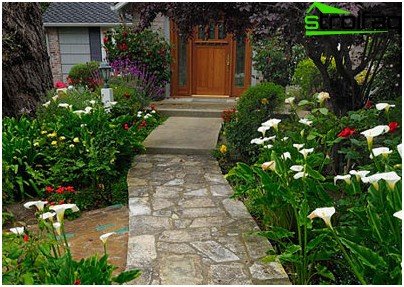
It is necessary to try to ensure that all elements of landscape design are harmoniously combined with each other
Types of paths and options for paths
Paths in the garden are divided into three main categories:
- rigid (made of concrete, wood, plastic, natural stone, clinker bricks);
- soft (made using pebbles, sand, gravel, wood chips);
- combined (combine both hard and soft textures).
Stone garden paths come in several forms. The easiest option is a path made of small material, such as pebbles, gravel or screenings. Ennoble such a path, laying on it individual stones of flagstone or paving slabs, mixborder, lawn are broken on the sides or a border is set.
Another kind of garden path is the “Swedish trail”, where 1 large stone falls at 1 step. They are laid at the level of the soil or literally 1 cm above it. You can make a sand pillow under each stone or on the entire path, and then fill the gaps with soil and sow lawn grass. Often, gardeners for the “Swedish trail” make artificial stones from concrete, which on the next day give the shape of real boulders.
To create a path in the garden with your own hands, these natural stones are most often used: gabbro, granite, basalt, labradorite, sandstone. The masonry process consists in creating a dense pattern without large gaps. To do this, first use the largest stones, then medium, and at the end fill holes and crevices with gravel. It is this masonry order that provides the most harmonious view of the garden path.
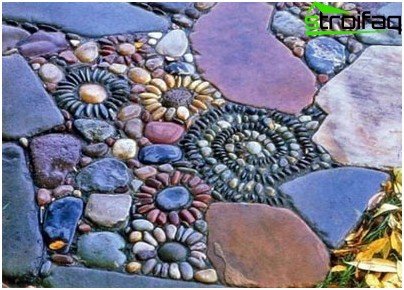
Using natural stone, you can create very beautiful and comfortable walking paths
Plastic and concrete garden paths
Recently, plastic garden paths have been very popular. This is not surprising, because the material is durable, looks beautiful, and its maintenance is minimal. And to build a path is not difficult, since it is going to be a constructor. For the junction of the track elements with borders, lawns and other decorative structures, special corners, expanders, sills are used.
Monolithic concrete tracks are durable and unpretentious. Refine them with colored mosaics, ceramics, pieces of ceramic tiles, shell rock. You can also add dye to concrete. In the gaps between the plates after they have completely dried up, unpretentious lawn grass is sown after 2 to 3 days. To create monolithic concrete elements of the trail, it is necessary to knock down a wooden formwork, which is filled with a hardening mixture.
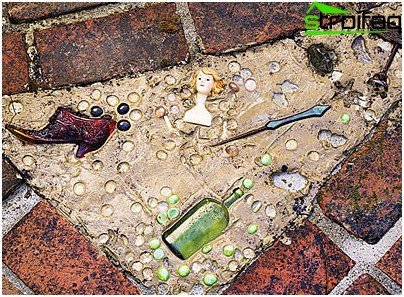
Various materials can be fixed in the slightly hardened concrete layer, which will make the path more aesthetic
Tiles for garden paths are very popular. They make it with the help of vibropressing or vibrocasting in molds. Paving slabs are a product made of cement, aggregate and special additives. If desired, and the presence of certain skills, you can make it with your own hands. For this, factory polystyrene formwork with dimensions of 60 * 60 cm is used. This form for garden paths is universal and fits perfectly at any angle. The polystyrene formwork must be lubricated with machine oil, which will make it easy to remove..
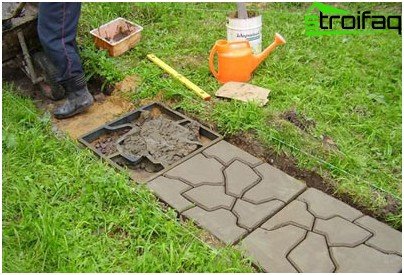
Ready-made polystyrene forms allow you to create beautiful and practical elements of paths
Features of laying tracks on the site
Correct garden paths consist of a sandy base, paving material, borders, and, if necessary, gutters. Work begins with the excavation of a trench in the width of the planned trail. In depth they remove up to 15 cm of soil. Then the bottom can be lined with geotextile, roofing material, preventing the germination of weeds. The base of the path is a layer of rubble, gravel, broken brick, sand. Tamp it thoroughly after watering it first..
The main material for paving is laid on top of the base, which, if necessary, is reinforced with concrete or cement. Borders give the tracks a well-groomed appearance. They are made of brick, natural stone, concrete curbs, wooden blocks, impregnated with antiseptics. Laying garden paths involves a slight slope of 1–4%, allowing rainwater not to stagnate. In addition, for wet areas use trays, ladders, boxes performing the role of drainage.
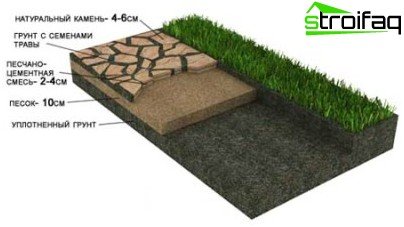
When laying track materials, it is very important to carefully tamp each layer.
The main material for secondary and walking paths, laid on a sand cushion without concreting, should be from 4 to 6 cm in thickness. This allows you to support the weight of a person pushing a loaded truck. For entry into the garage or on the economic site, the optimal height of the paving material is more than 7 – 10 cm.
Looking at garden paths with your own hands in the photo, you can draw a lot of interesting ideas for creating and decorating such a necessary element of a personal garden. It must be remembered that a well-made covering of the trail will last a long time if the materials are laid correctly.






